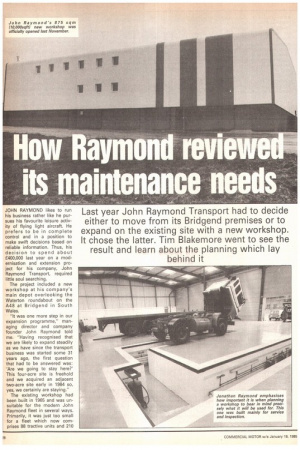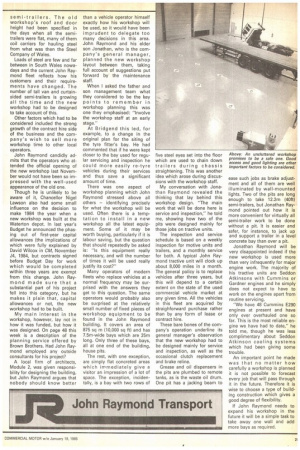Last year John Raymond Transport had to decide either to
Page 30

Page 31

If you've noticed an error in this article please click here to report it so we can fix it.
move from its Bridgend premises or to expand on the existing site with a new workshop. It chose the latter. Tim Blakemore went to see the result and learn about the planning which lay behind it
JOHN RAYMOND likes to run his business rather like he pursues his favourite leisure activity of flying light aircraft. He prefers to be in complete control and in a position to make swift decisions based on reliable information. Thus, his decision to spend about £400,000 last year on a modernisation and extension project for his company, John Raymond Transport, required little soul searching.
The project included a new workshop at his company's main depot overlooking the Waterton roundabout on the A48 at Bridgend in South Wales.
"It was one more step in our expansion programme," managing director and company founder John Raymond told me. "Having recognised that we are likely to expand steadily as we have since the transport business was started some 31 years ago, the first question that had to be answered was: 'Are we going to stay here?' This four-acre site is freehold and we acquired an adjacent two-acre site early in 1984 so, yes, we certainly are staying."
The existing workshop had been built in 1965 and was unsuitable for the modern John Raymond fleet in several ways. Primarily, it was just too small for a fleet which now comprises 88 tractive units and 210 semi-trailers. The old workshop's roof and door height had been specified in the days when all the semitrailers were flat, many of them coil carriers for hauling steel from what was then the Steel Company of Wales.
Loads of steel are few and far between in South Wales nowadays and the current John Raymond fleet reflects how his customers and their requirements have changed. The number of tall van and curtainsided semi-trailers is growing all the time and the new workshop had to be designed to take account of this.
Other factors which had to be considered included the strong growth of the contract hire side of the business and the company's wish to sell more workshop time to other local operators.
John Raymond candidly admits that the operators who attended the official opening of the new workshop last November would not have been so impressed with the well-used appearance of the old one.
Though he is unlikely to be aware of it, Chancellor Nigel Lawson also had some small influence on the decision to make 1984 the year when a new workshop was built at the Waterton depot. In last year's Budget he announced the phasing out of first-year capital allowances (the implications of which were fully explained by David Wilcox in CM, November 24, 1984, but contracts signed before Budget Day for work which would be completed within three years are exempt from this change. John Raymond made sure that a substantial part of his project fell into this category, but he makes it plain that, capital allowances or not, the new workshop had to be built.
My main interest in the workshop, however, lay not in how it was funded, but how it was designed. On page 48 this week is a description of the planning service offered by Brown Brothers. Had John Raymond employed any outside consultants for his project?
A local firm of architects, Module 2, was given responsibility for designing the building, but John Raymond argues that nobody should know better than a vehicle operator himself exactly how his workshop will be used, so it would have been imprudent to delegate too many decisions in this area. John Raymond and his elder son Jonathan, who is the company's general manager, planned the new workshop layout between them, taking full account of suggestions put forward by the maintenance staff.
When I asked the father and son management team what they considered to be the key points to remember in workshop planning this was one they emphasised: "Involve the workshop staff at an early stage."
At Bridgend this led, for example, to a change in the original plan for the siting of the tyre fitter's bay. He had commented that if he were kept closer to the bay used for regular servicing and inspection he could more easily re-tyre vehicles during their services and thus save a significant amount of time.
There was one aspect of workshop planning which John Raymond stressed above all others — identifying precisely for what the workshop will be used. Often there is a temptation to install in a new workshop all the latest equipment. Some of it may be worth buying, particularly if it is labour saving, but the question that should repeatedly be asked is: "Is this equipment really necessary, and will the number of times it will be used really justify its cost?"
Many operators of modern fleets who replace vehicles at a normal frequency may be surprised with the answers they get to this question. The same operators would probably also be surprised at the relatively small number of fixed pieces of workshop equipment to be found in the John Raymond building. It covers an area of 875 sq m (10,000 sq ft) and has 7.5m-wide bays which are 25m long. Only three of these bays, all at one end of the building, house pits.
The rest, with one exception, are simply flat concreted areas which immediately give a visitor an impression of a lot of space. The exception, incidentally, is a bay with two rows of five steel eyes set into the floor which are used to chain down trailers during chassis straightening. This was another idea which arose during discussions with the workshop staff.
My conversation with Jonathan Raymond revealed the thinking that lay behind this workshop design. "The main work that will be done here is service and inspection," he told me, showing how two of the pits were designed mainly for those jobs on tractive units.
The inspection and service schedule is based on a weekly inspection for motive units and trailers, and a monthly service for both. A typical John Raymond tractive unit will clock up about 8,000 miles in a month. The general policy is to replace vehicles after three years, but this will depend to a certain extent on the state of the used commercial vehicle market at any given time. All the vehicles in this fleet are acquired by straighforward purchase rather than by any form of lease or contract hire.
These bare bones of the company's operation underline its general manager's observation that the new workshop had to be designed mainly for service and inspection, as well as the occasional clutch replacement and brake reline.
Grease and oil dispensers in the pits are plumbed to remote tanks, as is the waste oil drum. One pit has a jacking beam to ease such jobs as brake adjustment and all of them are well illuminated by wall-mounted lights. Two of the pits are long enough to take 12.2m (40ft) semi-trailers, but Jonathan Raymond pointed out how it is more convenient for virtually all semi-trailer work to be done without a pit. It is easier and safer, for instance, to jack up and support a trailer in a level concrete bay than over a pit.
Jonathan Raymond will be very disappointed indeed if the new workshop is used more than very infrequently for major engine work. The majority of his tractive units are Seddon Atkinsons with Cummins or Gardner engines and he simply does not expect to have to work on the engines apart from routine servicing.
"We have 48 Cummins E290 engines at present and have only ever overhauled one so far. This is the most reliable engine we have had to date," he told me, though he was less complimentary about Seddon Atkinson cooling systems which had been giving some trouble.
An important point he made was that no matter how carefully a workshop is planned it is not possible to forecast every job that will pass through it in the future. Therefore it is wise to choose a type of building construction which gives a good degree of flexibility.
If John Raymond needs to expand his workshop in the future it will be a simple task to take away one wall and add more bays as required.














































































